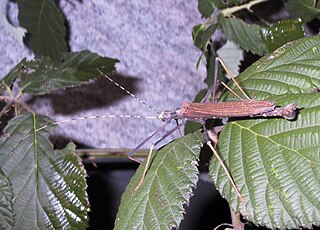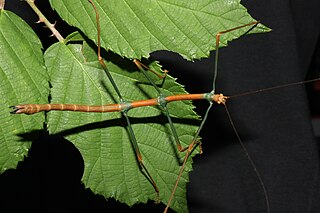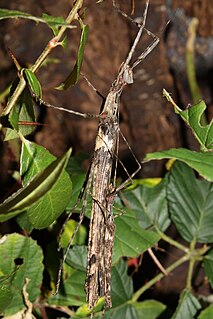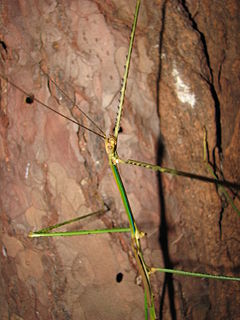
The Euphasmatodea, also known by its junior synonym Verophasmatodea is a suborder of the Phasmatodea, which contains the vast majority of the extant species of stick and leaf insects.
Mnesilochus is a genus of stick insects in the subfamily Lonchodinae. Species have a known distribution in: Borneo, Philippines, Sumatra.

The Phasmatidae are a family of the stick insects. They belong to the superfamily Anareolatae of suborder Verophasmatodea.

Phobaeticus is a genus of Asian stick insects comprising over 25 species. It includes some of the longest known insects, including Phobaeticus chani.

Pseudophasmatidae is a family of stick insect, in the suborder Verophasmatodea, commonly called the "striped walkingsticks". An important identifying characteristic is its mesothorax, which is never more than three times as long as the prothorax.

Necrosciinae is a subfamily of the stick insect family Lonchodidae, with its greatest diversity in South-East Asia.
Pharnacia is a tropical Asian genus of stick insects in the family Phasmatidae and subfamily Clitumninae.

Lonchodes is a genus of stick insects in the family Phasmatidae and the type genus of the family Lonchodidae and tribe Lonchodini. Species have a known distribution that includes tropical Asia and the Pacific.

Bacillidae is a stick insect family in the order Phasmatodea and the suborder Verophasmatodea.

Phryganistria is a genus of stick insects belonging to the subfamily Clitumninae. It was described by the Swedish entomologist Carl Stål in 1875. Members of the genus are found only in Southeast Asia. Of the new species described in 2014, Phryganistria heusii yentuensis, which is 32 cm long, is one of the longest insects known to date. Another, Phryganistria tamdaoensis was selected in 2015 by the International Institute for Species Exploration as one of the "Top 10 New Species" for new species discovered in 2014.

Aschiphasmatidae are a family of stick insects belonging to the suborder Verophasmatodea; they can be found in Indomalaya.

The Heteropterygidae is a family of stick insects belonging to the suborder Euphasmatodea. Species can be found in Australasia, East and Southeast Asia. More than 130 valid species are descriebed.

Diapheromerini is a tribe of walkingsticks in the family Diapheromeridae. There are at least 30 genera Diapheromerini.

Trachythorax is an Asian genus of stick insects in the family Diapheromeridae and subfamily Necrosciinae. Species have been recorded from the Indian subcontinent, Indo-China, Malesia through to New Guinea.

Pachymorphinae is a subfamily of stick insects in the family Diapheromeridae. Genera are primarily found in Africa, Asia and Australia.

The Clitumninae are a sub-family of stick insects in the family Phasmatidae found in Asia.
Tirachoidea is an Asian genus of stick insects in the family Phasmatidae and subfamily Clitumninae.

Lonchodidae is a family of stick insects, with more than 150 genera and 1,000 described species.

The Platycraninae are an anareolate subfamily of stick insects in the family Phasmatidae. Their known distribution includes southern, southeast Asia and Australasia.

The Obriminae are the most species-rich subfamily of the Phasmatodea family Heteropterygidae native to Southeast Asia. It is divided into two tribe.


















